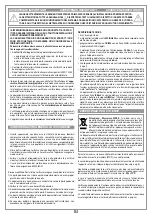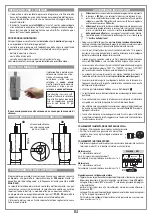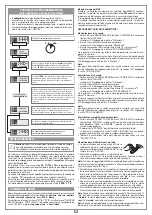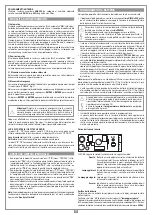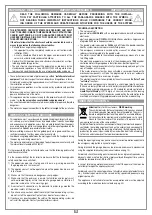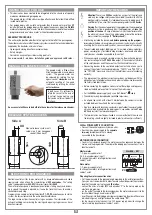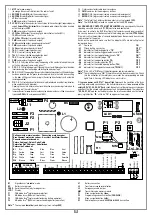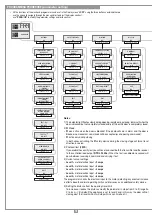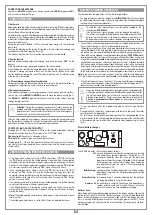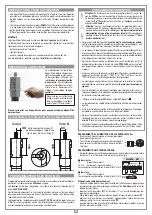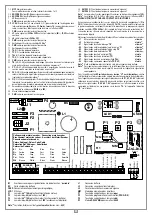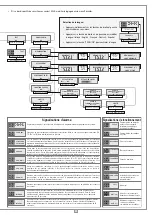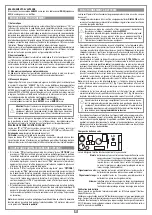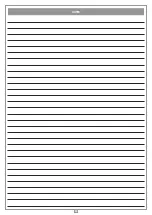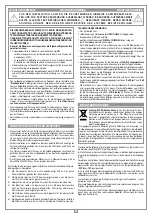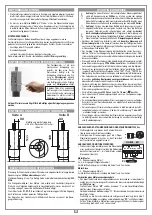
18
PROGRAMMING PROCEDURE
(door travel distance and current sensor)
Memory module (MM)
This is extractable, furnished with a non volatile EEPROM type memory and contains
the transmitter codes and allows you to memorise up to
300 codes
. The programmed
codes are maintained in this module even during blackouts.
Before memorising the transmitters for the first time remember to cancel the entire
memory content.
If the electronic card has to be replaced due to failure, the module can be extracted
from it and inserted into the new card. Make sure that the module is correctly
inserted as shown in fig. 2.
TRANSMITTER CODE MANAGEMENT
Memorising a channel
1. Scroll to the "MEMORISATION" step in the "REMOTE" menu and confirm using
the "PROG/OK" button:
the indication "Activation 1" will flash on the LCD.
2. Activate the transmitter channel that is to be memorised:
the indication "Activation 2" will flash on the LCD.
3. Activate the transmitter again (same transmitter, same channel
*
):
the indication "Code memorised" will flash on the LCD.
The number of channels already present in the memory is shown on the first line
in brackets.
*
If the channel is different or it is a different transmitter (point three) the memorisation
attempt will abort without success however "Activation 1" will still flash on the LCD.
Note:
It is not possible to memorise a code which is already in memory: if you attempt
this the indication "COD. IN MEM." (point one) will appear on the LCD.
Cancelling a channel:
1. Scroll to the "CANCELLATION" step in the "REMOTE" menu and confirm using
the "PROG/OK" button:
the indication "Activation 1" will flash on the LCD.
2. Activate the transmitter channel that is to be cancelled:
the indication "Activation 2" will flash on the LCD.
3. Activate the transmitter again (same transmitter, same channel
*
):
the indication "Code cancelled" will flash on the LCD.
The number of channels already present in the memory is shown on the first line
in brackets.
*
If the channel is different or it is a different transmitter (point three) the cancellation
attempt will abort without success however "Activation 1" will still flash on the LCD.
Note:
It is not possible to cancel a code which is not already in memory: if you
attempt this the indication "COD. NOT MEM." (point one) will appear on the LCD.
Cancelling all user codes from memory:
1. Scroll to the "CANCEL ALL MEMORY" step in the "REMOTE" menu and con-
firm using the "PROG/OK" button: a procedure confirmation request "CANC
ALL MEMORY?" will appear on the LCD (press one of the arrows to exit the
procedure).
2. Press the "PROG/OK" button to confirm the total cancellation:
the indication "CANCELLING" along with a progress bar will appear on the
display.
3. Once the total cancellation has been carried out the display will return to "CANCEL
ALL MEMORY".
Memorising ulterior channels via radio
• The system can be remotely activated using radio control devices; (without opening
the receiver) by setting "MEMO RADIO" has been activated in the "OPTIONS"
menu.
1. Using a transmitter, in which at least one channel
button "
A, B, C
or
D
" has already been memorised
in the receiver, press the button in the transmitter
as shown in figure.
Note:
all the receivers within range when the channel
button is pressed (and which have at least one of the
transmitter channel buttons memorised) will activate their signal buzzer "
B1
" (fig. 2).
2. Press one of the channel buttons on the same transmitter. The receivers which do
not contain that channel code will sound a five-second long "beep" and will then
deactivate. The receivers which contain the channel code will sound a one-second
long "beep" and will enter the "
programming via radio"
mode.
3. Press the previously chosen channel buttons on the transmitter which you wish to
memorise; the receiver will sound 2 "beeps" of half a second each after which the
receiver will be ready to receive another code.
4. To leave the programming mode wait for 3 seconds without pressing any buttons.
The receiver will sound a five-second long "beep" and will then exit the program-
ming mode.
Note:
When the memory is entirely occupied the buzzer will sound 10 rapid "beeps"
and will automatically leave the "
programming via radio
" mode.
The same signal is given each time you try to enter "
programming via radio
" when
the memory is full.
Note:
the memo radio procedure can only be carried out after programming has
terminated and you have quit the setting/programming menu.
•
The installation of anti-derailment buffers is
absolutely obligatory
.
• Make sure the safety devices are at rest and the ECU is receiving mains power
otherwise you will not be able to enter programming.
• It is not possible to enter programming when working off battery power.
• Before programming set the main operating parameters in the "OPTIONS"
menu.
REPOSITIONING
Attention!
During the repositioning manoeuvre the current sensor value
could be altered. At the end of the manoeuvre, however, it will reset
automatically to the chosen value.
If the programmer blocks due to an encoder count error ("Error ENC" on the dis-
play), after a programmer reset ("Out of pos.") or when there is a problem with the
motor ("Mot error") the warning lights and indicator light will flash simultaneously for
2 seconds
and will then switch off for
10 seconds
.
If in this stage you send a (
TA, TC, TAL
or
TD
) command to the programmer.
The programmer will move the door slowly to the completely closed position (2 times
as in the programming procedure) in order to recover the correct position.
At this point the programmer will function normally. If a "
TA
" command is given the
positioning recovery is carried out in the opening direction.
No commands will be accepted during repositioning but the security devices will cut
in and block all movement if they go into alarm.
To interrupt the repositioning manoeuvre press the "
PROG
" or "
TB
" button.
The system can be remotely activated using radio control devices; each channel
has a choice of 6 possible functions:
open - shut - limited opening - sequential
command - CH2 output - stop
.
To set the functions to channels "
A
","
B
","
C
","
D
" use the command "CHANNEL
FUNCTIONS" from the "REMOTE" menu. The sequential command may be set to
"
open-stop-shut-stop
" or "
open-close
".
REMOTE CONTROL
1...4... sec.
The pause time count will start (
min. 2 seconds: max.
120 seconds
) indicated by "
PAUSE
" and the elapsed
time appearing on the display
Press “
PROG
” to set the pause time to the required value.
The door will now open slowly in order to find the
completely open position.
When the door reaches the completely open travel limit it will
invert the travel direction and after moving a few centimetres
it will open again to confirm the completely open position. At
this point the door will start to close. When the door reaches
the completely closed travel limit it will invert the travel
direction and after moving a few centimetres it will close
again to confirm the completely open position.
After having carried out this manoeuvre the logic control will
open then close the door completely in order to calibrate
the current sensor.
When the door reaches the completely closed position the
programmer saves the parameters and quits the programming
mode.
The operation has not succeeded. You will have to
repeat the programming procedure.
Press and hold down prog/ok for 4 seconds
“PROG/OK” for 4 sec.
“PROG/OK”
“PROG/OK”
PROGRAM
T B
F S
F I
CP
T B
F S
F I
CP
PROGRAM
T B
F S
F I
CP
PAUSE
AUTO PROG.
PAUSE 005
AUTO PROG.
T B
F S
F I
CP
OPENING
AUTO PROG.
AUTO-PROGRAMMING
CYCLE
T B
F S
F I
CP
CLOSING
AUTO PROG.
T B
F S
F I
CP
T B
F S
F I
CP
MEMORIZZAZIONE CODICE TX-RX
RCQ449100
13-04-2001
DM0531
Description :
Product Code :
Date :
Drawing number :
P.J.Heath
CARDIN ELETTRONICA S.p.A
- 31020 San Vendemiano (TV) Italy - via Raffaello, 36 Tel: 0438/401818 Fax: 0438/401831
Draft :
All rights reserved. Unauthorised copying or use of the information contained in this document is punishable by law
MR
Summary of Contents for 305/GLi824
Page 2: ...2 NOTES ...
Page 12: ...12 NOTES ...
Page 20: ...20 NOTES ...
Page 28: ...28 NOTES ...
Page 36: ...36 NOTES ...


